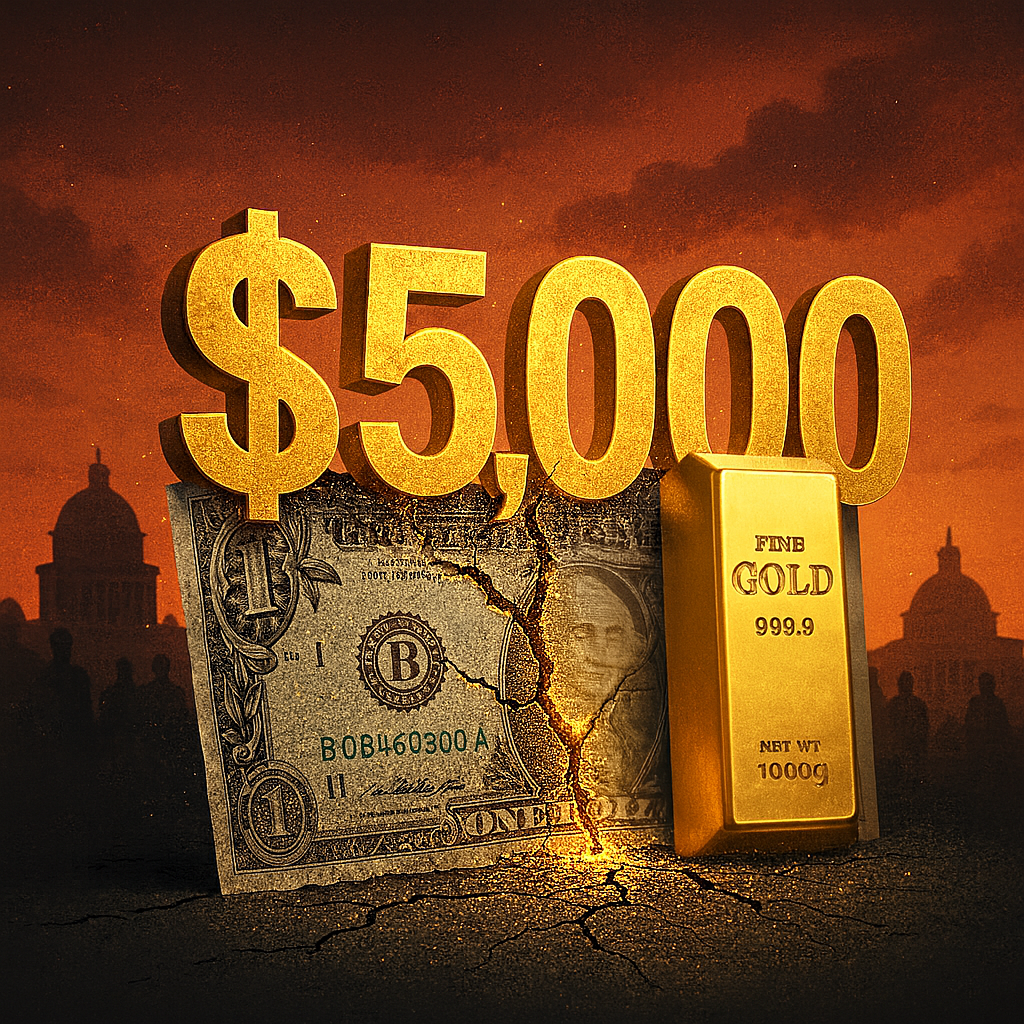Gold just crossed four thousand dollars per ounce. The question isn’t if it stays there. It’s whether five thousand breaks the system.
I’ve been tracking precious metals markets for years, but the 51% surge in 2025 feels different. The drivers aren’t the usual suspects. Something structural shifted beneath the surface.
The rally delivered gold’s strongest quarterly return since 1986. That performance came from a specific mix: central bank buying, ETF inflows, a weaker dollar, and retail investors hedging against trade tensions and geopolitical uncertainty.
But the real story lives in the institutional behavior.
The Reserve Rebalancing Nobody Talks About
Central banks aren’t just buying gold anymore. They’re restructuring their entire reserve base.
A World Gold Council survey of 73 central banks revealed that 95% expect to increase
their gold holdings over the next 12 months. Nearly three-quarters plan to shrink their dollar reserves simultaneously.
That’s not portfolio adjustment. That’s a wholesale shift in how sovereign wealth gets stored.
The numbers back it up. Central banks accumulated over 1,000 tonnes of gold in each of the last three years. Compare that to the 400-500 tonne average over the preceding decade. Poland alone made a single 100-tonne purchase in early 2025, bringing their total holdings past 400 tonnes.
China’s central bank added gold for the 11th straight month through September.
This creates a powerful price floor that didn’t exist before. When the world’s largest institutions become consistent net buyers, volatility patterns change. Dips get bought. Corrections stay shallow.
What Billionaires See In The Data
His exact words: “We’re seeing substantial asset inflation away from the dollar as people are looking for ways to effectively de-dollarize, or de-risk their portfolios vis-a-vis US sovereign risk.”
When one of the world’s most successful hedge fund managers publicly worries about dollar displacement, that’s a signal worth examining.
The institutional flow supports his concern. Gold ETF trading volumes exploded to $8 billion per day in September, an 84% month-over-month increase. North American funds led the surge with $6.5 billion daily, accounting for 78% of physically-backed ETF trading volumes.
India added $902 million in gold ETF inflows despite elevated prices. The demand came from investors seeking safe havens amid weaker domestic equities and persistent geopolitical risk.
Even retail demand shows resilience. Indian gold jewelry traffic rebounded with gold-exchange programs gaining traction. When consumers keep buying at $4,000, that tells you something about their confidence in alternative stores of value.
The Goldman Sachs Projection
The revision reflects confidence in sustained demand drivers. Central bank buying continues. ETF inflows remain strong. Geopolitical tensions show no signs of easing. Real yields stay compressed.
But here’s where it gets interesting.
If Goldman’s projection holds, gold will have climbed from roughly $2,000 in early 2024 to nearly $5,000 by late 2026. That’s a 150% move in under three years. For a market this size, with this much institutional participation, that kind of appreciation suggests something beyond a typical bull cycle.
The broader precious metals market confirms the strength. Silver broke through $44 in September, reaching 14-year highs. By October, it tested $48.71, approaching its all-time peak from 2011. When silver moves in tandem with gold, the rally has legs.
What Five Thousand Means
The $5,000 threshold matters for reasons beyond round numbers.
At that level, gold’s market capitalization relative to global financial assets crosses into territory that forces broader recognition. Portfolio managers who ignored precious metals at $2,000 can’t ignore them at $5,000. Allocation models get rewritten. Risk calculations change.
More importantly, sustained prices above $5,000 validate the de-dollarization thesis. If central banks can successfully shift reserve composition away from Treasuries toward gold without triggering currency crises, other nations follow. The precedent gets set.
Macro strategist Tavi Costa noted that foreign central banks now hold more gold than US Treasuries for the first time since 1996. He called it “likely the beginning of one of the most significant global rebalancings we’ve experienced in recent history.”
That rebalancing accelerates above $5,000.
The Correction Risk
I’d be dishonest if I didn’t mention the other side.
Market analysts are flagging stretched valuations. A more hawkish Federal Reserve stance could trigger near-term selling. Quick resolution to fiscal uncertainties might reduce safe-haven demand. Profit-taking after a 51% run becomes increasingly likely.
Bitcoin’s recent behavior offers a parallel. It briefly touched $125,000 before experiencing sharp weakness due to dollar strength and profit-taking. Gold could follow a similar pattern if the dollar rebounds aggressively.
The technical setup suggests vulnerability to a 10-15% pullback. That would take gold back to $3,400-$3,600, still well above previous resistance levels but enough to shake out leveraged positions.
But pullbacks in a structural bull market create entry points, not exit signals.
What I’m Watching
The forward indicators matter more than the current price.
I’m tracking central bank purchase data monthly. If the 95% survey figure translates into actual buying, the price floor rises regardless of short-term volatility.
I’m watching ETF flow patterns. Sustained institutional inflows above $5 billion daily suggest conviction, not speculation.
I’m monitoring the dollar index. Gold’s inverse correlation to dollar strength remains intact. Any prolonged dollar weakness accelerates the gold rally.
And I’m paying attention to what sovereign wealth funds do quietly. Public data lags, but their allocation shifts telegraph where smart money sees value in a changing monetary system.
The $4,000 threshold already broke. The question now is whether $5,000 breaks something else entirely.













